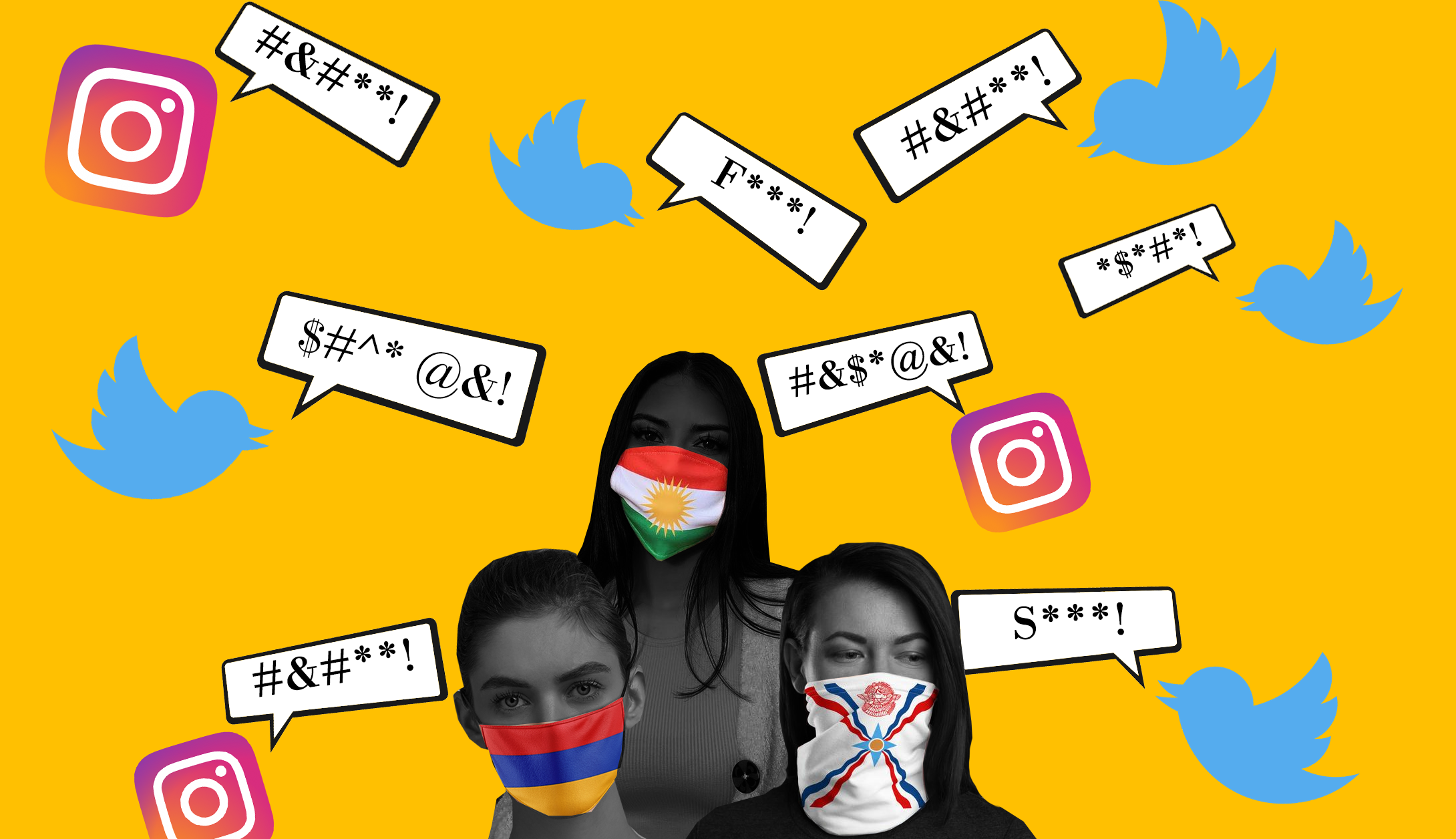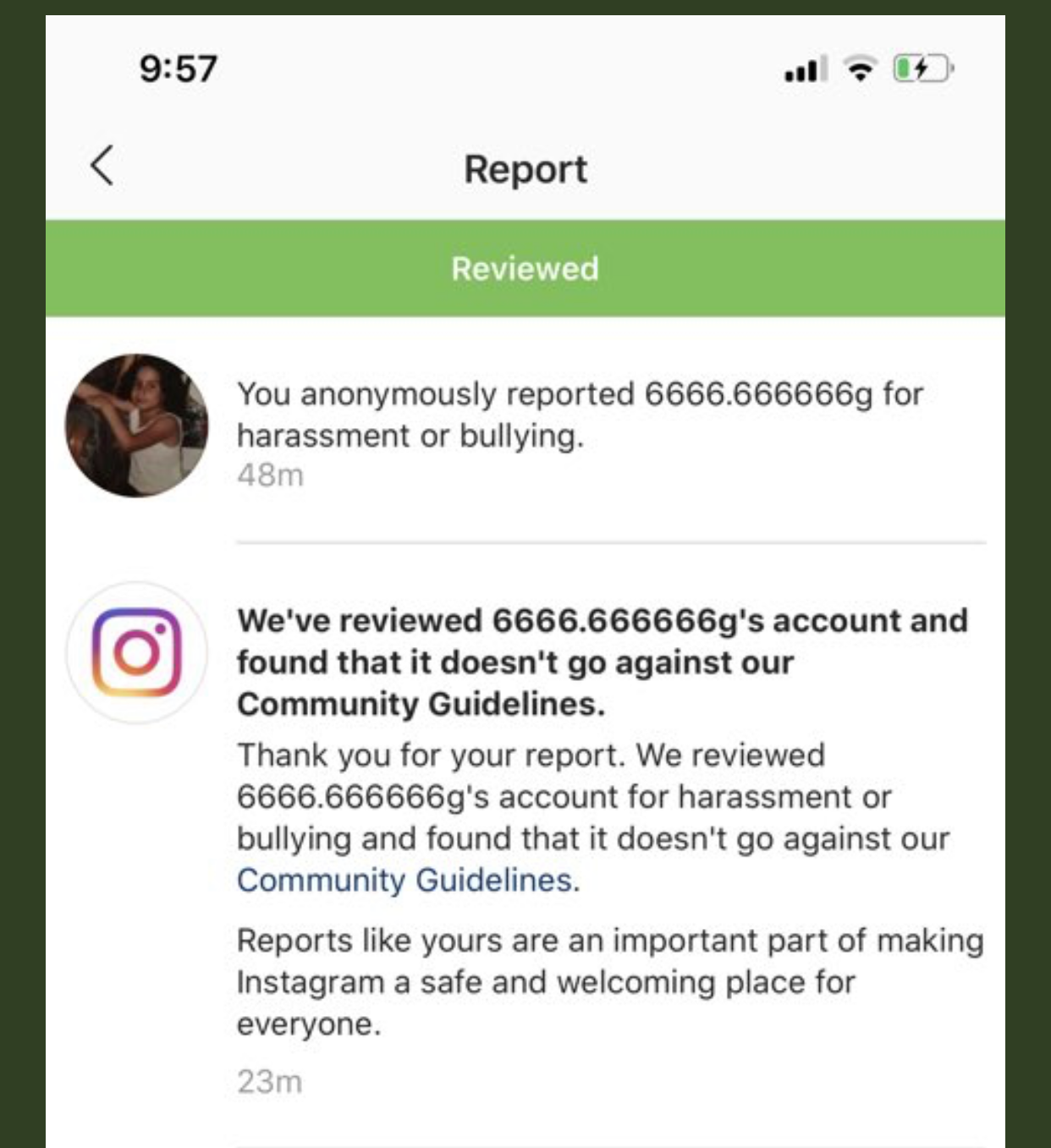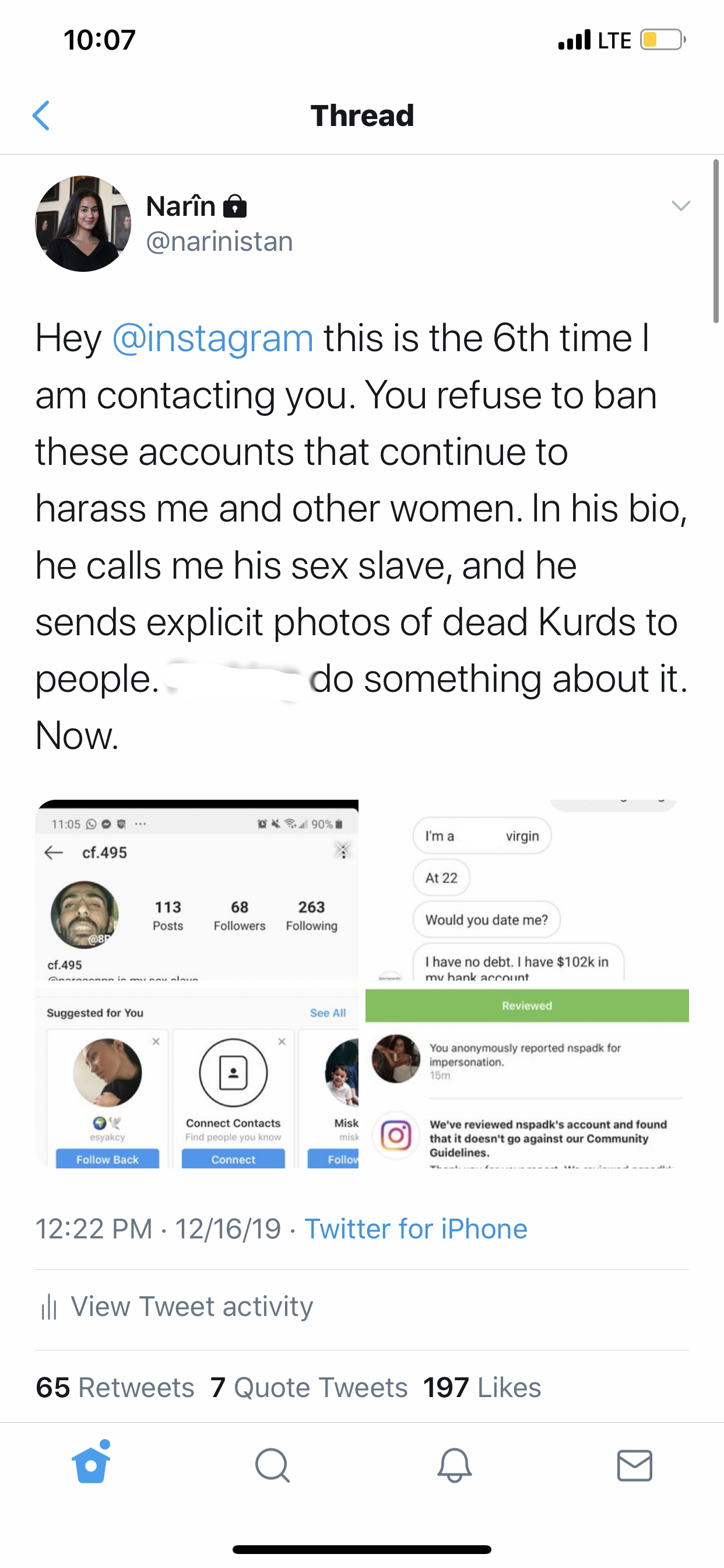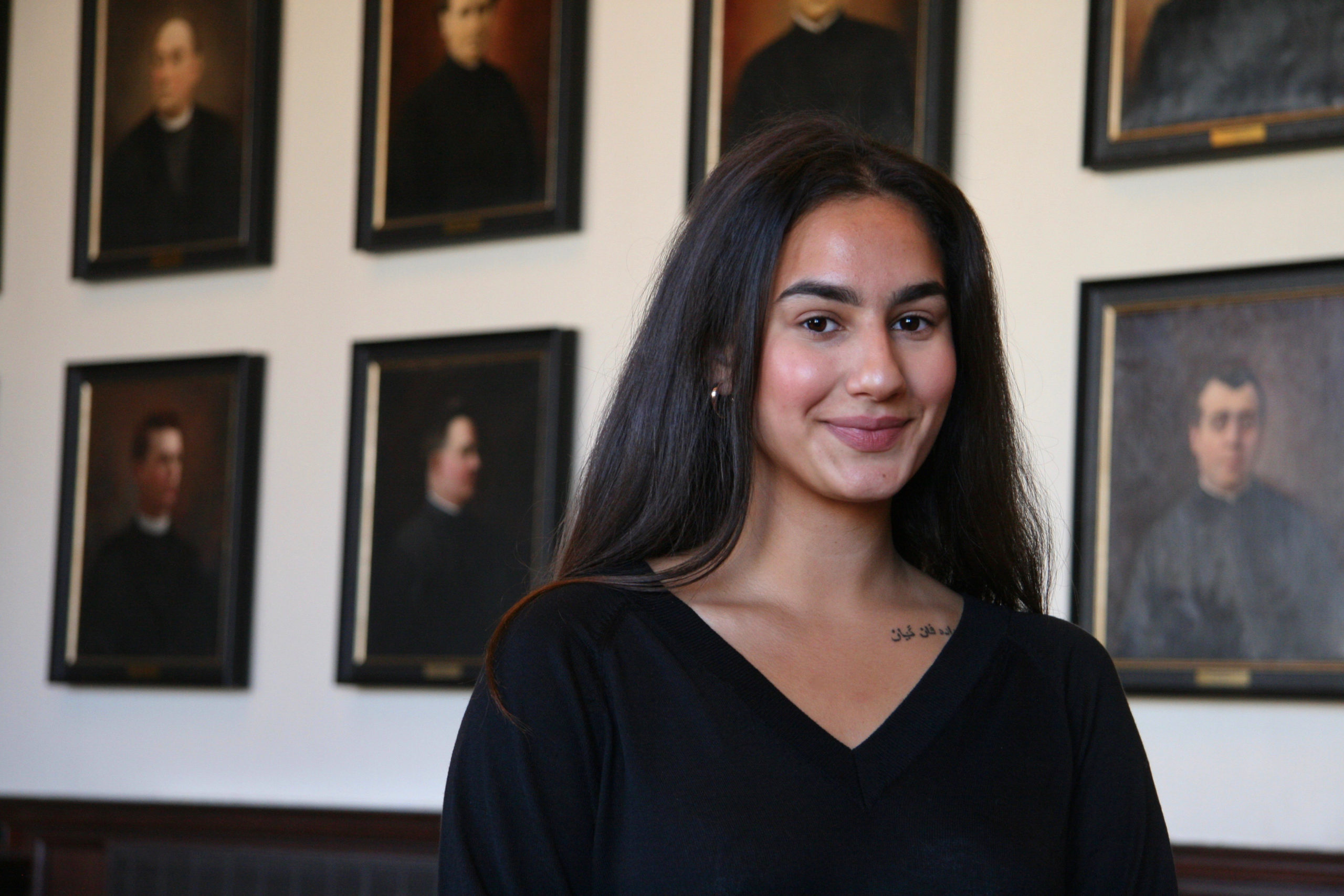
So reads the gruesome admission of one Kurdish law student on Twitter: “They sent me pictures of dead Kurdish women, and told me they would do the same thing to me. Also [there is] a video where a Kurd was beheaded by a Turkish soldier. I still remember the sound it made when the Turkish soldier threw away the head and laughed. I get a lot of rape threats and insults daily.” Platforms like Twitter and Instagram vow to keep their users safe by upholding a number of rules regarding hate speech and violence, but these rules hardly ever apply to Turkish nationalists.
Over the past several days, I have gathered more than 450 testimonies from men and women who have continuously endured violent threats from Turkish accounts. On its website, Twitter states, “You may not threaten violence against an individual or a group of people. We also prohibit the glorification of violence.” Instagram similarly states, “Graphic violence is not allowed and we may remove videos or images of intense, graphic violence to make sure that Instagram stays appropriate for everyone.” However, the evidence I gathered from personal experience and discussion groups online blatantly reveals the neglect these platforms have towards the communities that are subjected to this abuse daily.

More than 450 people, including intellectuals, artists, academics, doctors and students, gathered together virtually to compile screenshots, paperwork and other forms of digital and physical evidence documenting the harassment they have endured from Turkish nationalists online. Many of these people are women of Armenian, Kurdish, Yazidi and Assyrian descent. The current treatment of these threats is entirely inconsistent with Twitter and Instagram’s policies. We challenge the degree to which these so-called “standards” that Twitter and Instagram possess are upheld.
Armenian activists have especially fallen victim to this harassment given the current bombardment of Artsakh by Turkish and Azeri-backed forces. Platforms like Instagram and Twitter have only remained complicit in the intimidation and harassment of Armenian individuals.
Following are statements from several Armenian activists:
“Some said they wanted to destroy me and my whole existence, others were rape threats. I get those every day,” said one Armenian journalist working for a major news platform in the US.
Another academic at Columbia University shared deeply disturbing messages from a Turkish account, which went into gruesome detail of how he would like to murder and degrade this woman’s body. The comments still remain online, despite the direct violation of the platform’s “guidelines.”
One young Armenian on Twitter was told she would be slaughtered by an account that remains unchecked and continues to live online despite reports made against it.

Yet alas, activism is not the reason for provoking such hate from Turkish accounts. Simply existing is enough to warrant months of death threats. Take Helin, for instance. She’s a young Kurdish woman who posted a picture with a face mask that depicted the Kurdish flag. Almost immediately after posting her photos, she was met with death threats. For months, she received thousands of spam messages threatening her life, simply for being Kurdish. These death threats and spam accounts are still up and running today, despite the many reports made to Twitter and Instagram. Her photo was also used in several Turkish media outlets that called for her page to be attacked.
In addition to allowing threats to remain online, these social media platforms have also directly banned, or shadow banned, accounts. This restriction of user content is blatant censorship.

Another Kurdish activist has stated, “For months now, I have endured physical threats, harassment and spam accounts from Turkish ultra nationalists who seek to shut my page down. One person specifically has created over 11 different accounts, to which they share my profile photo and caption the photo with various forms of sexual assault threats and degradation. Each time I have reported these accounts for harassment, bullying, physical violence, and even impersonation (as one account pretended to be me), Instagram and Twitter refuse to remove these accounts. In fact, Instagram and Twitter both responded to the following incidents where various accounts have posted my photo with captions such as, ‘We’ll make you our next sex slave Kurdish B*tch with a note that stated none of these accounts had violated the platform’s guidelines. It seems as though sending violent, sexually charged threats and graphic photos of dead Kurds and Armenians is completely fine with these social media sites. Not to mention the instance in which a hit-list created by a Turkish page with more than 300,000 followers stayed up on the site despite the many reports made of the account. The owner of the account created a list of Kurdish and Armenian accounts in addition to any ally of these respective causes – to which each contributor of this list described how eager they were to ‘bash their heads in while they are asleep.’” No action was taken from Twitter in these instances.
This complicity seems to directly contradict Twitter’s recent posts which state, “Tweets that wish or hope for death, serious bodily harm or fatal disease against *anyone* are not allowed and will need to be removed.” This statement obviously does not apply to the Kurds, Armenians and members of various ethnic groups that have fallen victim to death and rape threats from Turkish nationalists.
As history has long dictated, Turkish nationalism has fueled decades of senseless massacres, war and genocide. We have seen it through the Armenian Genocide, the invasions of northeastern Syria, the Dersim Massacre and the current Turkish-backed Azeri invasions and bombardment of Artsakh and Armenia. The intention of this article is not to apply equivalency to these instances of tragedy amongst various groups like the Armenians, Kurds or Assyrians. Rather the goal is to offer a background as to how various communities have endured censorship from the Turkish state beyond the state’s borders and the digital repercussions of Turkish state nationalism in the modern age of technology.
To demonstrate, a Twitter account that was strictly dedicated to teaching the Kurdish language, with more than 20-thousand followers, was removed from Twitter. There was no reason offered as to why this account was removed, nor did any of the content violate the rules. As for Instagram, accounts that have threatened to beat or initiate gendered violence against multiple women, despite the many reports that have been made against them, still exist. According to more than 230 Instagram users, there is a specific individual of Turkish descent living in Sweden who has created over 14 accounts through which he harasses and sends violent threats to multiple women.
“Turkish nationalists simultaneously gaslight you and call you a liar while threatening violence or justifying the violence against your family,” says California-based Armenian activist Sophia Armen “[This] is the racist trauma inflicted by Turanism (also known as Turkish nationalism). Its goal is your erasure and your fear. We are seen as subhuman to them. When you are an Armenian woman who speaks about her family’s stories or even if you are just an Armenian woman expressing political opinions, those who defend the Turkish state view you as a threat. You are a threat to power, and the goal of Turanism (or Turkish nationalism) is your physical erasure and silence.”
It is evident that Turkish state censorship and intimidation extend beyond the borders of Turkey.
Some may trivialize these attacks or reduce them to “mere cyberbullying,” but one need not look far to see that these cyberattacks are only a small reflection of the ongoing consequences of nationalism that are prevailing for Armenians, and even Kurds, globally. Recently the Turkish diaspora began setting the homes of Kurdish residents on fire in Vienna, Austria while Turkey was invading and looting the homes of civilians in northeast Syria. Just last month, an Armenian community center in San Francisco was set on fire following the vandalism of an elementary school with hate speech. This is an ongoing issue that will continue to prevail unless our institutions, including social media platforms, begin to take these threats seriously.

Moving forward, if Twitter and Instagram genuinely seek to keep their “communities safe,” I suggest that they begin banning accounts of those who incite violence against the platforms’ users. This includes banning the IP addresses of the Turkish individuals who have made multiple accounts to harass women. This includes the Turkish account with more than 300,000 followers that has created a hit list in an attempt to harm Kurdish, Armenian, Assyrian and other individuals. This includes banning comments and messages that remain active despite the content’s violation of each respective platform’s policy. Twitter and Instagram must move forward to protect their users coming from vulnerable minority communities.



Well done. The hate speech and hate crimes keep piling up, and the cyber-harassment is a significant and deeply disturbing component of this worldwide anti-Armenian campaign by Azeris and Turks. The fact that Twitter, Facebook, and Instagram *enable* the harassers is highly problematic. In so doing, they encourage acts such as the Grey Wolves lynch mobs and hammer-knife attacks of peaceful protesters (near Lyon, France on Oct. 28, 2020). This list of recent hate crimes is from end July. Sadly it must be updated:
https://medium.com/@zoravik/our-response-to-azeri-hate-crimes-vandalism-and-attacks-on-peaceful-protestors-46de9a49f617
And here, more on the Grey Wolves:
https://mena-studies.org/the-grey-wolves-conquering-europe/?fbclid=IwAR0lCrAejJA_-PviQ4WbiD8R3W6FF1AyIxg8vQkZAKLmugkaMZybgc3UJn8